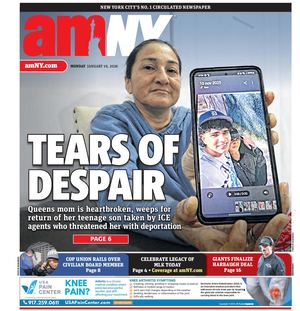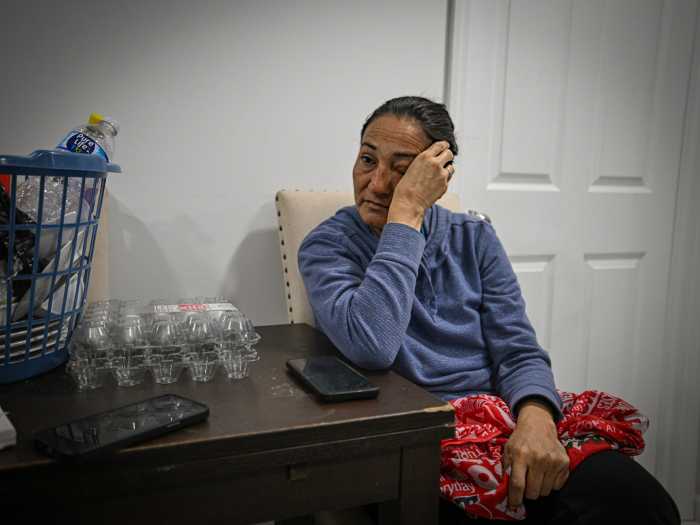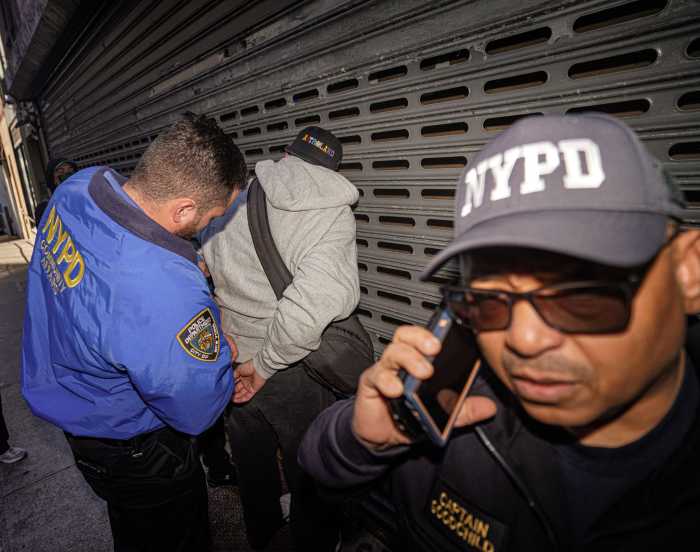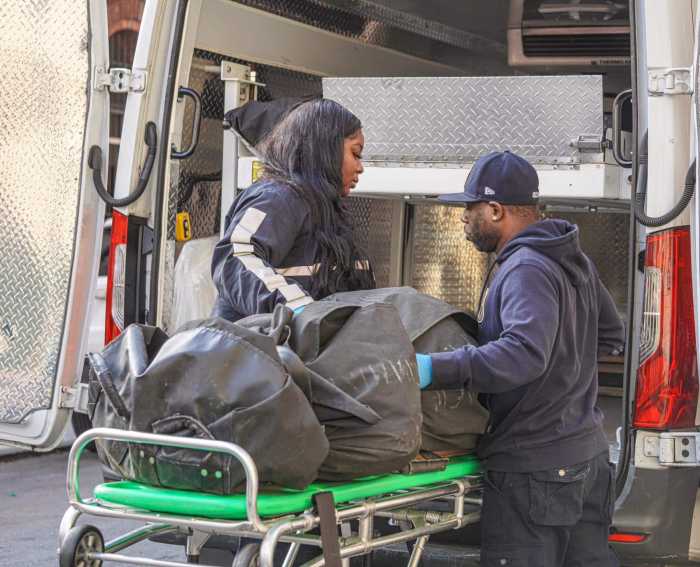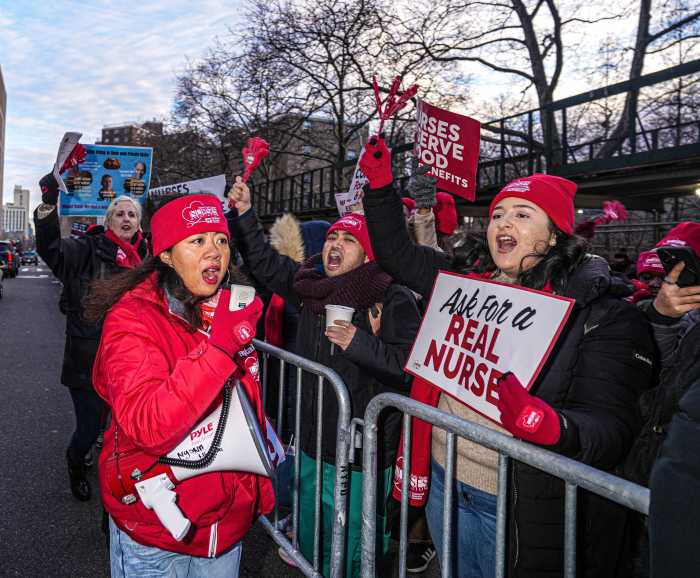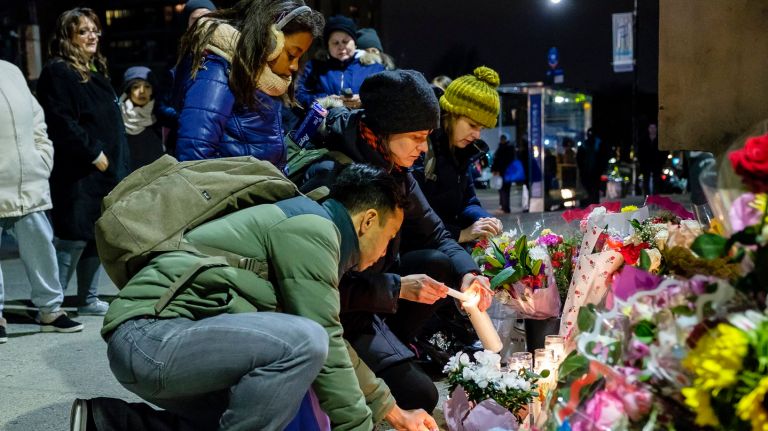
Following this month’s fatal crash in Brooklyn, Mayor Bill de Blasio on Thursday called for Albany to pass a series of law changes in an attempt to keep dangerous drivers off the road.
The mayor has outlined three policy changes he wants the state to enact by June: an increase in and expansion of school zone speed cameras; ramped up fines and penalties, including vehicle registration suspensions, for vehicles caught speeding or running red lights on camera; and a new policy that would require physicians to alert the Department of Motor Vehicles of drivers’ medical conditions or events.
“[There’s] a glaring gap in the law that if you’re pulled over by an officer for these type of offenses, there was a clear sanction,” said de Blasio at a news conference in Brooklyn’s 78th Precinct. “But if your car was caught on a speed camera repeatedly it didn’t lead to the same outcome.”
The changes are geared toward preventing crashes like the one that occurred March 5, when an infant and small child were killed while crossing a Park Slope intersection after a driver had run a red light. The vehicle of the driver involved in the fatal crash had racked up four speed camera and another four red light camera violations since 2016, according to city data.
The driver, Dorothy Bruns, said she had experienced a medical episode at the time and has not been charged with a crime. However, her license has been suspended.
The deaths inspired a protest at the mayor’s gym, just up the block from the crash site at Ninth Street and Fifth Avenue, as well as a march through Brooklyn streets led by children calling for increased traffic safety measures. And the city announced last week that it would redesign Ninth Street with physically protected bike lanes and other pedestrian-friendly treatments.
Currently, speed or red light camera violators are slapped with $50 fines for each offense but do not risk loss of driving privileges unless they fail to pay. Under the mayor’s proposal, those fines would be increased to $150 for the third offense; $250 for the fourth; $300 for the fifth; and $350 for the sixth, which would be coupled with a registration suspension.
Under state law, a driver’s vehicle registration could be suspended following three unpaid red light or speed camera violations within an 18-month period. Tiffany Portzer, a spokeswoman for the Department of Motor Vehicles, said the city runs the camera programs and has not reported any such cases.
“Like all New Yorkers, we were horrified by last week’s crash and are disturbed by reports of rampant traffic violations,” Portzer added in a statement. “We will of course review any potential legislation the city proposes to strengthen its traffic safety programs and keep dangerous drivers off the roads.”
In the face of rising traffic deaths across the country, de Blasio has managed to drive deaths down to historic lows under his Vision Zero safety initiative. School zone speed cameras, currently allowed to be operated at 140 schools across the city during school hours, have played a key part in the efforts, according to Polly Trottenberg, the city’s transportation commissioner. She said speed is the most important factor in street safety.
“There’s a logical reason, no matter what’s happening on the streets, if you’re driving at a safe speed you’re going to have more reaction time,” she said. “If there’s a collision, there’s less likely to be a fatal consequence.”
But critics have said the mayor has not wholeheartedly embraced or clearly understood Vision Zero, an initiative born in Sweden in the 1990s. When asked at Thursday’s event, the mayor said he would also be “willing to look at” legislation that would penalize pedestrians for texting and walking, which goes against the key principles of Vision Zero that emphasize infrastructure design flaws.
Doug Gordon, a Park Slope resident and advocate who organized the protest outside of the mayor’s gym, applauded the mayor for continuing the push for more speed cameras. He also said the ramped-up fines were a “good start,” but the mayor is overlooking what the city itself could do to improve street safety.
“It does feel a little bit like he’s punting to Albany,” Gordon said. “There’s a lot that he could be doing here at the city level that he’s not really doing. The space of street redesigns seems pretty stagnant, or just not accelerating at the pace that it should . . .
“The crash on Monday — people are right that we don’t know street design could have changed it,” he continued. “But so many of the crashes that we see could have been prevented with good design and right now the process for rolling those designs is very slow.”
City lawmakers in attendance on Thursday looked toward Albany, expressing frustration that the city doesn’t have more control of the outlined enforcement changes.
“Today should not be about finger pointing,” Queens Councilman Donovan Richards said. “But we really have to take a look at why it is that we have to go to the state in the first place to ask for speed cameras.”
De Blasio’s administration has lobbied the state unsuccessfully in the past to expand the speed camera legislation that the city had drafted, which brought cameras to school zones in 2014. On Thursday, the mayor repeated those past requests: add 150 more locations for cameras and redefine “school zone” to allow the city to add cameras to streets that are near schools, not just streets where school entrances are located.
“I want to say to everyone in Albany, ‘This cannot be about politics. It cannot be about political convenience,’” de Blasio. “Everyone at this point has to recognize it’s a matter of life or death.”
